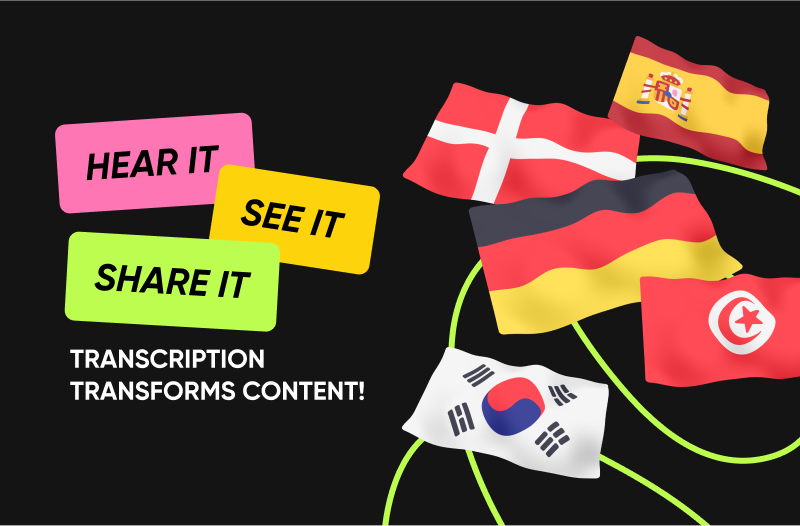
Not Sure Which Languages to Choose?
Want to know how easy it is to turn video content into text? Or maybe you're wondering what tools can make transcription a breeze? Let's dive into the best practices and tools that will help you get the job done right.
Transcriptions can make your content more accessible, searchable, and even translatable. In this guide, we’ll break down the best practices and tools for video transcription, with a special focus on reaching audiences across different languages.
Why Should You Care About YouTube Video Transcription?
Making Your Content Accessible to All
Transcribing your videos ensures that everyone can enjoy your content, including those who are hard of hearing or speak different languages. It’s not just about following accessibility guidelines, it’s about opening up your content to as many people as possible.
Boosting Your SEO
Did you know that search engines can’t “read” your video content? They rely on text to understand and rank it. By transcribing your videos, you’re making them more discoverable, especially on platforms like YouTube, where a good transcription can really boost your ranking.
Global Reach
Want to reach new markets? Transcriptions are your gateway to translating and localizing your content. Once you have a solid transcript, it’s much easier to translate your video into multiple languages, helping you connect with audiences all over the world.
YouTube recommends AIR Media-Tech for content translation and localization, and here's why – we handle it all for you. From translating and dubbing your content into over 50 languages to tailoring it perfectly for local audiences, we’ve got you covered. Ready to take your content global and boost your earnings? Just reach out to us!
Best Practices for Video Transcription
- Choose the Right Transcription Method
There are three main methods for transcribing video content:
- Manual Transcription
This is the most accurate method but also the most time-consuming. You’ll need to listen and type everything out.
- Automated Tools
Tools like Otter AI, Rev, and Trint can speed things up, but they might need some tweaking, especially with tricky audio.
- Professional Services
Professional services balance speed and accuracy for high-stakes content, often including quality checks as part of the deal.
- Ensure High Audio Quality
Good audio = good transcription. The clearer your audio, the fewer mistakes you’ll have, whether you’re doing it manually or using software.
- Use Time-Coded Transcriptions
Time-coding connects your transcript to specific parts of the video, which is a lifesaver for long videos or when translating content into other languages.
- Follow Transcription Style Guides
Consistency is key in transcription. Develop or adhere to a style guide that outlines how to handle different elements like speaker identification, sound descriptions, and punctuation. This is especially important when multiple people are involved in the transcription process.
- Always Do a Quality Check
Even if you’re using automated tools, don’t skip the proofreading. Cross-check your transcript with the video to catch any errors and make sure everything’s spot on.
- Think About Cross-Language Transcription
Translating into other languages? Remember that some languages take more words to say the same thing, which can affect timing. Native speakers can help make sure everything flows naturally with cross-language video transcription.

Tools to Help You Transcribe Like a Pro
1. Otter AI
Otter AI is one of the most popular video transcription services. It is great for real-time transcription with integrations for Zoom and Google Meet platforms. It is also perfect for meetings, interviews, and webinars, though it might need some manual editing.
2. Rev
Rev offers both automated and human transcription services. While the automated service is faster, the human transcription option provides higher accuracy, especially for professional content that requires a polished final product. Rev also supports multiple languages, making it a good choice for global businesses.
3. Trint
Trint combines AI-driven transcription with editing tools that allow you to clean up the transcript directly within the app. It also supports collaboration, making it easier for teams to work together on transcription projects. Trint’s accuracy is generally high, but it works best with clear, well-recorded audio.
4. Happy Scribe
Happy Scribe offers both automated and manual transcription services. It’s known for its ability to handle multiple languages. The platform also includes features like speaker identification and time-coding.
5. Temi
Temi is an affordable transcription tool that supports multiple languages. It’s part of the Rev family, so it shares some of the same features, such as speaker identification and time-coding. Temi is particularly useful for users on a budget who still need reliable transcription services.
6. Veed IO
Veed IO offers transcription services along with video editing tools, making it a comprehensive solution for content creators. The platform supports multiple languages and allows you to create captions and subtitles directly within the app. It’s a good choice for creators who want an all-in-one tool for video production.

Best Practices for Multilingual Transcription
So, once again, to ensure that everything is professional with your transcription, follow this guide:
- Start with Accurate Video Transcriptions
Before translating your content, ensure that the original transcription is as accurate as possible. This reduces the risk of errors during the translation process, which can lead to misunderstandings or misinterpretations in the final product.
- Work with Native Speakers
Native speakers can help you navigate cultural nuances and ensure that the translation makes sense in context.
- Use Professional Translation Services
Professional services can offer that extra layer of quality assurance for top-quality multilingual content.
- Consider the Length of Translations
Some languages take more words to say the same thing. Adjust your video timing accordingly, using time-coding to manage these differences.
- Test Your Transcriptions
Before going live, have native speakers review your transcriptions to catch any errors and make sure everything’s culturally appropriate.
Transcription Quality Assurance
- Review and Edit
Always double-check your initial transcription, especially if you’re using automated tools.
- Cross-Check with Video
Make sure your transcript matches the video perfectly – this step is crucial for keeping your content clear and understandable.
- Use QA Tools
Many transcription tools offer quality assurance features like grammar checks – use them to catch any missed errors.
- Incorporate Feedback
Whether you’re working with a team or using a service, get feedback from others to fine-tune your final product.

Secure Video Transcription
- Use Secure Platforms
Choose transcription tools with strong security features, like end-to-end encryption, especially if you’re dealing with sensitive content.
- Set Up Access Controls
Make sure only authorized users can view or edit your transcripts, particularly if they contain confidential information.
- Data Privacy
Check your platform’s data privacy policies to ensure your content is handled securely, and consider using features like data anonymization if needed.
Transcribing your videos isn’t just a nice-to-have, it’s a powerful tool that can make your content more accessible, boost its discoverability, and extend its reach to a global audience. By following best practices and using the right tools, you can create transcriptions that resonate with people all around the world.

If you’re looking to expand your content even further, partnering with AIR Media-Tech. We will provide you with the support and tools you need to succeed in the global market. For more detailed insights and professional help, reach out to AIR Media-Tech.
So, embrace the power of transcription and unlock the full potential of your video content!





